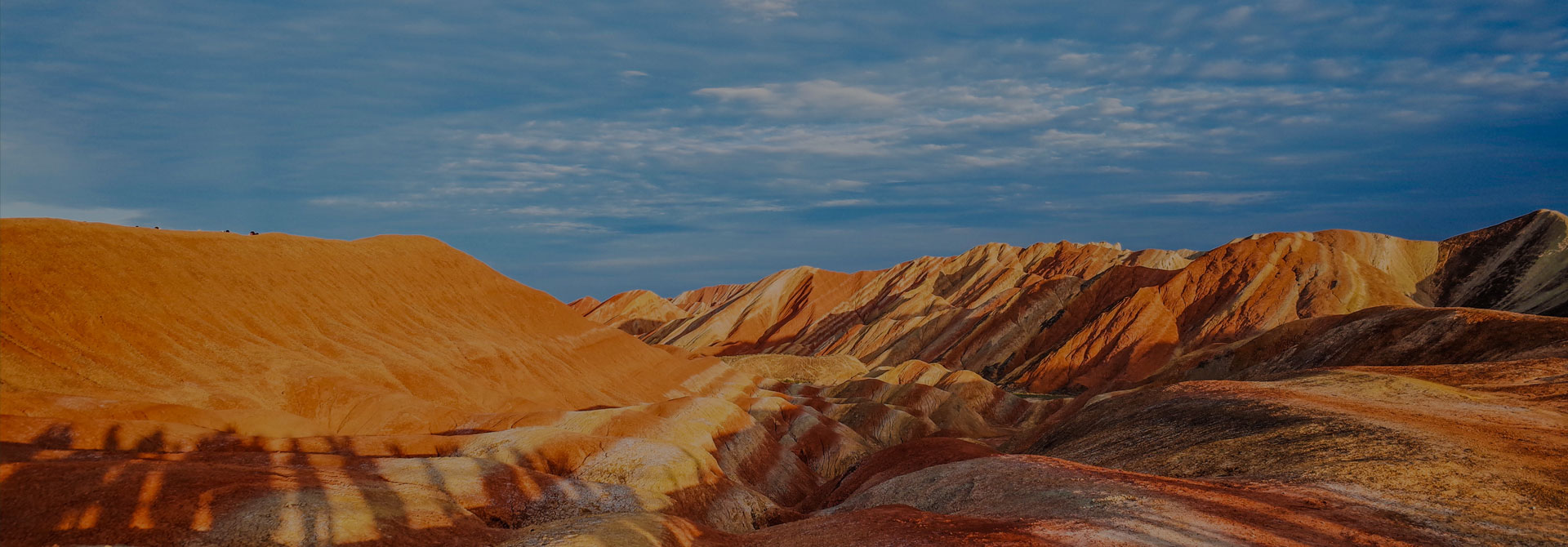
1.Purpose of the survey
Using the geophysical exploration method to detect the distribution range and landfill volume of waste molecular sieves in the field
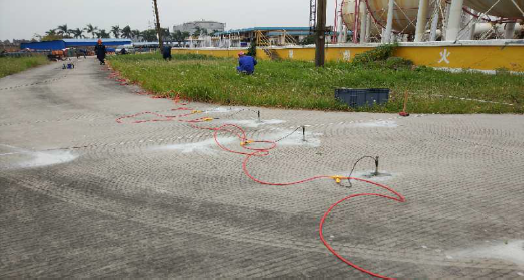
Using electrical resistivity (Tomography) for geophysical exploration
(Because of the high resistivity of the molecular sieve backfill in generally so it has obvious electrical difference with the surrounding groundwater in the underground medium.Then the non-invasive resistivity (ERT) method has some advantages in detecting the range and depth of waste landfill sites)

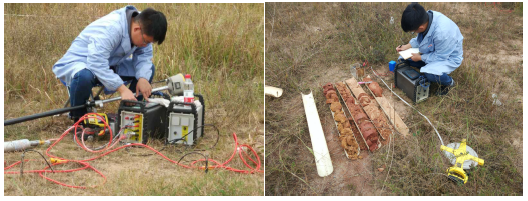
On-site Program
GD-20 multi-channel workstations and RTK
2.2 Cable configuration
The reasonable arrangement of survey lines can ensure the acquisition of high-quality data. This survey area is 26000m2 in total. The survey area is wired with regional grid with spacing between 20 and 30m, and total of 18 ERT survey lines are laid
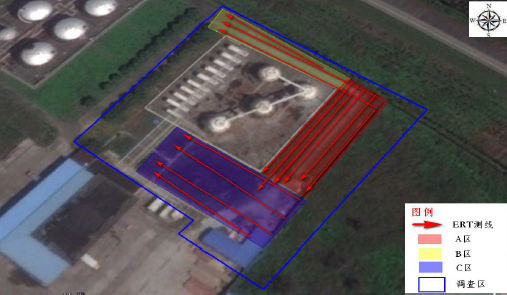
The resistivity method is a geophysical method based on the difference in dielectric resistivity. The detection principle of the DC resistance method is to establish an artificial electric field by using a direct current to pass a pair of current poles A and B into the ground. By the difference in conductivity between the interlayer media, another potential pair M, N can be used to measure the potential difference between the electric field between M and N, thereby obtaining the apparent resistivity of the formation and estimating the conductivity distribution of underground formation.
Advantage
1.Deep depth, small terrain effect
2.Graphical representation of underground structures
3.Can be applied to well investigation
4.2D, 3D, 4D analysis
5.More specific quantitative indicators
6.Resistivity 20% or more difference with high resolution
7.Can be combined with other electrical surveys
Disadvantage
1.Long time measurement
2.Required enough linear wiring space
3.Micro-sabotage survey
4.Certain line or side interference effect
5.Difficult to identify if the background value is too similar to the target resistivity feature
The field judgment is mainly based on the distribution of shallow soil disturbance and the distribution of extremely high resistivity anomaly. According to the characteristics of the resistivity medium, the overall electrical profile is mainly divided into two layers, and the resistivity distribution tends to decrease with the deepening of the depth. It is speculated that the main molecular sieve anomalies appear in the red part of the test line. The main physical properties of the site are backfill and original layers from top to bottom. Surface backfill is distributed throughout the region, waste molecular sieves are scattered buried in backfill soil, resistivity morphology is bowl shaped accumulation, buried depth are very shallow, the average buried depth is about 1 meter.
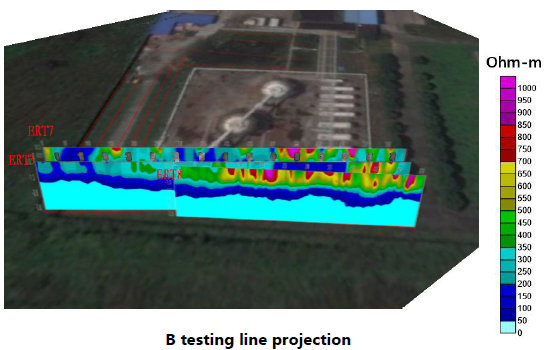
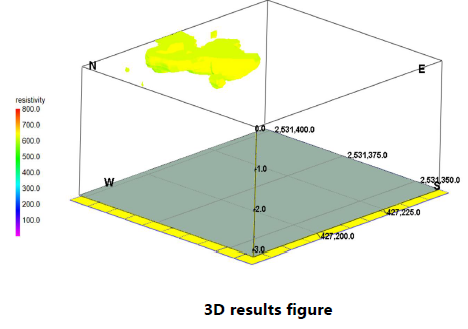
ERT3 speculates that the burial location falls between the survey line 65-76 meters and the burial depth is about 1 meter. There is no obvious bowl-shaped accumulation in ERT-7. It is speculated that the high resistance in this area should be caused by gravel and construction waste. In the horizontal position of ERT-8 between 11-40 meters, 42-50 meters and 52-54 meters, there is a relatively high resistance anomaly. The resistivity morphology is a bowl-shaped accumulation. It is speculated that it is likely to be a landfill of molecular sieves. About 0.5-1 meters deep. The main physical properties of the site are backfill and original soil layer from top to bottom. The surface backfill is distributed in the whole area. The waste molecular sieve is messily buried in the backfill soil. The resistivity morphology is bowl-shaped. The buried depth is very shallow, with an average buried depth of about 0.8 meters
4.3 Results
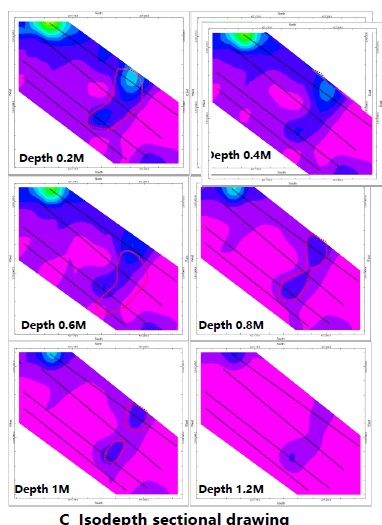
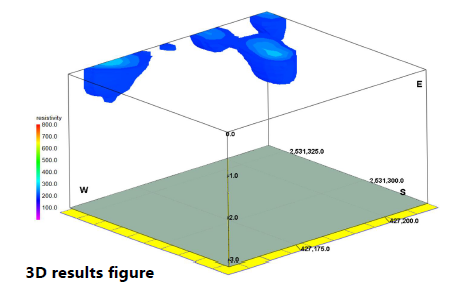
The results of the is depth section can clearly depict the abnormal area , as shown by the dotted line. The relatively high resistance area of this anomaly decreases with the change of depth. It is speculated that the resistivity of this anomaly may be slightly higher than the background value due to the mixing of high-resistance materials. The main physical properties of the site are surface backfill and original layer from top to bottom, the surface backfill is distributed throughout the region, the waste molecular sieve is scattered buried in the backfill soil, the resistivity morphology is bowl-shaped accumulation, the burial depth is very shallow, and the average burial depth is about 0.8 meters.
4.4 Whole Field Projection Results

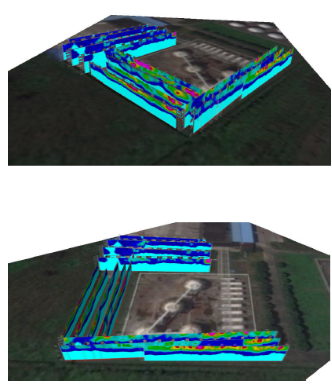
1.The site molecular sieve distribution is messy from the overall evaluation and it is not a unified landfill. Combined with the results of the resistance image profile method, the burial depth is very shallow, the average burial depth is about 0.8-1 meters.
2.From the thickness characteristics of the physical layer, the main physical layer in the field is the surface backfill and the original layer from top to bottom.Surface backfill is distributed throughout the region, waste molecular sieves are scattered buried in backfill soil, resistivity morphology is bowl shaped accumulation, buried depth are very shallow, the average buried depth is about 1 meter.
3.Based on the 3D results, the buried area of the abandoned molecular sieve backfill was estimated to be about 734 square meters and the volume was about 472 cubic meters
4.The overall evaluation of the site molecular sieve distribution is messy, not a unified landfill, at the same time, combined with the results of the resistance image profile method, the average burial depth of about 0.8-1 meters.
5.From the thickness characteristics of the physical layer, the main physical layer in the field is the surface backfill and the original layer from top to bottom.The surface backfill is distributed in the whole region, the waste molecular sieves are scattered buried in the backfill soil, the resistivity morphology is bowl-shaped accumulation, the burial depth is very shallow
6.Based on the 3D results, the buried area of the abandoned molecular sieve backfill was estimated to be about 734 square meters and the volume was about 472 cubic meters.
5 .Advantages of Geophysical Methods
1.Geophysical method is non-damage and nondestructive investigation
2.Compared with the traditional geological sampling method, geophysics is the measurement of underground landfills and stratigraphic structures not only no need drilling but also can abtaine continuous section data through a large range of measurements
3.Investigation of contaminated site, no borehole exposure, prevents the further spread of pollution, environmental protection, no secondary pollution.
4.The depth of sounding is large and accurate, which can not only qualitatively delineate the contaminated area of the site, but also divide the stratigraphic structure of the site and judge the groundwater depth and direction of the site